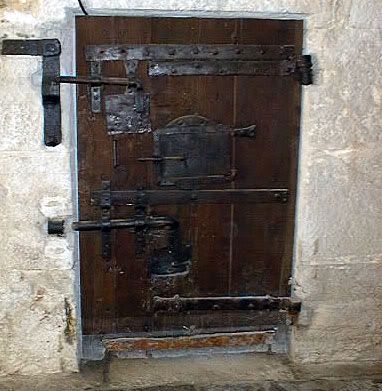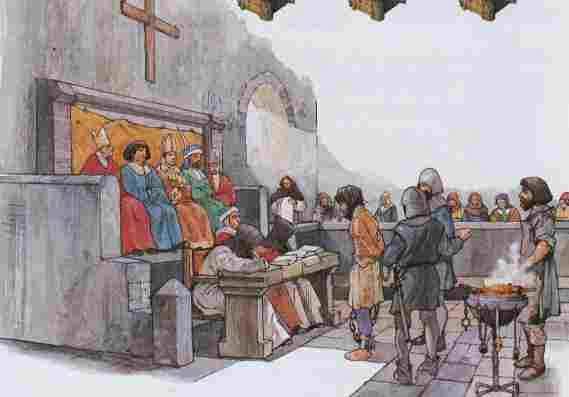Madame de Volange and Natasha returned with the warm cookies. Madame then poured cognac for all of us. We sat and exchanged small talk at her table as we enjoyed the cookies and a very fine vintage Napoleon cognac.
Madame then asked me to help her get something. She led me down a dark hallway at the end of which was an ancient prison cell door.
Taking a keyring full of antique keys from her coat pocket, she selected a large old skeleton key and ulocked the great padlock on the door. She asked me to remove the padlock and open the door. The padlock weighed at least ten pounds and was several hundred years old judging by the crude craftsmanship of its heat-hammered rivets and iron plate. The door consisted of hammered wrought iron hinges and and bars that were bolted to thick planks of oak. I had to slide the lockbar open before I could open the door. Small flakes of rusted iron fell to the floor as I slid the lockbar open. The door was extremely heavy and took a great deal of strength to open as it swung slowly for what was probably the first time in years on its dry creaking hinges.
The door opened into a small musty prison cell. Upon one wall hung two sets of shackles bolted to the walls by short lengths of medieval chain. The cell reminded me of a religious inquisition, an ecclesiastical kangaroo court ruled over by violent religious idiots:
Madame de Volange flipped an old electrical switch and a faint incadescent light bulb illuminated the dark room. There was a large cedar box on the floor that had metal fittings. I recognized the box as being an airtight museum storage box. My estimation was correct as next to the box was a large metal cylinder of nitrogen that was used to purge the box of air when it was closed after each use. Madame asked me to carry the large box back to the table. The box was heavy. I wondered what was inside.
Bill and Natasha turned to look at me carrying the large box down the hallway towards them. Madame walked ahead of me and asked Natasha to clear the table. She then gestured for me to place the box on the floor as I approached.
I placed the box on the floor and we all gathered around as Madame de Volange again took the ancient iron loop keyring from her pocket, selected an old key, and unlocked the large padlock on the box. She had me open the box. Inside were two packages wrapped in black velvet with one stacked upon the other.
Madame had me take the first package and place it on the table. She undid the wax seal on the front fold of the black velvet and pulled the velvet apart so that we could see what was inside. It was a very sleek wooden box that had an excellent finish on it. She opened the the hinged lid and we were all amazed to see a pristine vintage E-Meter. A highly polished brass plate engraved with the intials "LRH" was mounted on the face of the meter just below the dial.
"It is the first E-Meter that Hubbard had made by Volney," she told us. We all stared at each other in amazement. Madame said nothing else as she gestured for me to take the second package out of the box. I did and placed it next to the E-Meter. Again, Madame broke the wax seal on the black velvet and opened the package.
It was an old manuscript bound by a leather strap. The cover page read:
Excalibur: The Secrets of Life.
Copyright 1948, by L. Ron Hubbard
Bill gasped.
It was quite an astonising thing to see the first E-Meter and the fabled lost Excalibur manuscript!
/////
skip to main |
skip to sidebar
Followers
Blog Archive
-
▼
2009
(14)
-
▼
May
(9)
- J. Swift's Paris Travel Journal -- Part VIII
- J. Swift's Paris Travel Journal -- Part VII
- J. Swift's Paris Travel Journal -- Part VI
- J. Swift Paris Travel Journal -- Part V
- J. Swift's Paris Travel Journal -- Part IV
- J. Swift's Paris Travel Journal -- Part III
- J. Swift's Paris Travel Journal - Part II
- J. Swift's Paris Travel Journal: Part I
- Sergeant L. Ron Hubbard, USMC
-
▼
May
(9)


